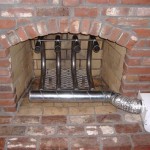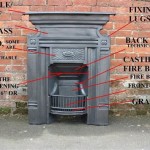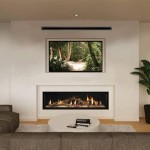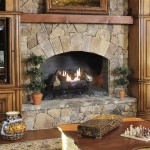Living Room Furniture Arrangement Ideas with a Corner Fireplace
Arranging furniture in a living room that features a corner fireplace presents a unique set of design challenges and opportunities. The fireplace, traditionally a focal point, commands attention and influences the flow of the room. Successfully incorporating this architectural element into the overall design requires careful consideration of space, functionality, and aesthetic balance. This article will explore various furniture arrangement strategies for living rooms with corner fireplaces, focusing on optimizing space utilization, enhancing visual appeal, and creating a comfortable and inviting environment.
The corner fireplace’s placement inherently dictates the primary axis of the room. Unlike a fireplace centered on a wall, a corner fireplace necessitates a diagonal approach to furniture placement. This diagonal orientation can sometimes make it difficult to create defined zones within the room. Therefore, a strategic approach to furniture arrangement is essential to avoid a cluttered or disjointed appearance.
Before moving any furniture, it’s crucial to measure the dimensions of the room and the fireplace itself. Accurate measurements will help determine the optimal size and placement of furniture pieces. Consider the distance from the fireplace to the nearest walls and windows, as this will influence the placement of larger items such as sofas and entertainment centers. It's also beneficial to create a rough sketch of the room, noting the location of doorways, windows, and electrical outlets. This visual aid can facilitate the planning process and help prevent costly mistakes.
Establishing a Focal Point and Defining Zones
While the corner fireplace naturally serves as a focal point, the arrangement of the surrounding furniture can either enhance or detract from its prominence. To create a cohesive and visually appealing space, consider these strategies:
Angled Seating Arrangement: The most common approach is to angle the primary seating, typically a sofa or sectional, towards the fireplace. This arrangement creates a natural conversational grouping and emphasizes the fireplace as the central element of the room. The angle of the sofa should be adjusted to provide a comfortable viewing angle of the fireplace without obstructing the flow of traffic through the room. Complementary seating, such as armchairs, can be placed perpendicular to the sofa, creating a more intimate gathering space. Coffee tables and area rugs can further define this zone.
Balancing the Fireplace with a Secondary Focal Point: In larger rooms, it may be desirable to introduce a secondary focal point to balance the visual weight of the fireplace. This could be an entertainment center, a large piece of artwork, or a prominent window with a view. When incorporating a secondary focal point, ensure that it complements the fireplace rather than competing with it. The scale and style of the secondary focal point should be carefully considered to maintain a sense of harmony within the room. For example, if the fireplace is rustic and traditional, a sleek, modern entertainment center might clash with the overall aesthetic.
Creating Defined Zones: Depending on the size and intended use of the living room, it may be beneficial to create distinct zones for different activities. For example, one zone could be dedicated to conversation and relaxation around the fireplace, while another zone could be used for reading or working. Area rugs, strategically placed furniture arrangements, and even changes in flooring can help delineate these zones. In smaller rooms, multi-functional furniture, such as a sofa bed or a coffee table with storage, can help maximize space and functionality.
Optimizing Space and Traffic Flow
Beyond aesthetics, a well-designed living room should also be functional and practical. Optimizing space and ensuring smooth traffic flow are essential considerations when arranging furniture around a corner fireplace.
Avoiding Obstructions: One of the most common mistakes is placing furniture in a way that obstructs doorways or pathways. Ensure that there is ample space to move freely around the room without having to navigate obstacles. Consider the natural traffic patterns and arrange furniture to facilitate these movements. For example, avoid placing large furniture pieces directly in front of doorways or windows.
Utilizing Vertical Space: In smaller rooms, maximizing vertical space can help create the illusion of more room. Tall bookshelves or shelving units can provide storage and display space without taking up valuable floor space. Mirrors can also be used to reflect light and create a sense of spaciousness. When using vertical elements, ensure that they are balanced with the rest of the furniture to avoid overwhelming the room.
Creating Visual Balance: Maintaining visual balance is crucial for creating a harmonious and inviting atmosphere. Avoid concentrating all the large furniture pieces on one side of the room, as this can create a sense of imbalance. Distribute the weight of the furniture evenly throughout the space. This can be achieved by pairing larger pieces with smaller ones and incorporating accessories such as lamps, plants, and artwork to fill in the gaps. Consider the color and texture of the furniture and accessories as well, ensuring that they complement each other and contribute to the overall visual balance of the room.
Furniture Selection and Placement Considerations
The type and style of furniture chosen play a significant role in the overall success of the living room arrangement. Consider these specific furniture placement strategies when working with a corner fireplace:
Sofa Placement: The sofa is typically the largest piece of furniture in the living room, and its placement is crucial for defining the space. As previously mentioned, angling the sofa towards the fireplace is a common and effective approach. However, the specific angle and distance from the fireplace will depend on the size of the room and the size of the sofa. In smaller rooms, a smaller sofa or loveseat may be more appropriate. In larger rooms, a sectional sofa can provide ample seating and create a more defined zone around the fireplace. The sofa should be placed at a comfortable distance from the fireplace to allow for easy conversation and viewing.
Chair Placement: Armchairs are essential for creating a comfortable and inviting seating arrangement. They should be placed strategically to complement the sofa and provide additional seating options. Armchairs can be placed perpendicular to the sofa, facing the fireplace, or arranged in a circular formation to encourage conversation. Consider the height and style of the armchairs when selecting them. Taller armchairs can help balance the height of the fireplace, while lower armchairs can create a more relaxed and casual atmosphere. Ottomans can also be added to provide additional comfort and functionality.
Coffee Table and Area Rug Placement: The coffee table and area rug are essential accessories for defining the seating area and adding visual interest to the room. The coffee table should be placed within easy reach of the sofa and armchairs, providing a convenient surface for drinks, books, and other items. The size and shape of the coffee table should be proportional to the size of the sofa and the overall dimensions of the room. The area rug should be large enough to anchor the seating area and tie the furniture together. The rug should extend at least partially under the front legs of the sofa and armchairs to create a cohesive and unified look. The color and pattern of the area rug can be used to add visual interest and complement the overall color scheme of the room.
Entertainment Center Considerations: If incorporating an entertainment center, it should be placed in a way that does not compete with the fireplace. Ideally, it should be placed on a wall that is perpendicular to the wall containing the fireplace. Avoid placing the entertainment center directly across from the fireplace, as this can create a cluttered and unbalanced look. The size and style of the entertainment center should be carefully considered to ensure that it complements the rest of the furniture and the overall aesthetic of the room. A floating entertainment center can help save space and create a more modern look.
By carefully considering these furniture arrangement ideas and placement considerations, it is possible to create a living room that is both functional and aesthetically pleasing, effectively showcasing the corner fireplace as a central element of the design.

Arranging Furniture With A Corner Fireplace Brooklyn Berry Designs

How To Design Around A Corner Fireplace

How To Arrange Furniture With A Corner Fireplace Setting For Four Interiors

Discover The Charm Of Kellswater In Orange County Ca

25 Corner Fireplace Living Room Ideas Interior God

Awkward Living Room Layout With Corner Fireplace

How To Arrange Furniture With A Corner Fireplace Living Room Arrangement Farm House
:max_bytes(150000):strip_icc()/293766550_3286591041608177_5896860344492471976_n-0d9152dc46b04db18e63a8d5f6eb6ed9.jpg?strip=all)
8 Decor Tips For An Awkward Living Room With A Corner Fireplace

Awkward Living Room Layout With Corner Fireplace

How To Arrange Furniture Around A Corner Fireplace Bloom In The Black
Related Posts








